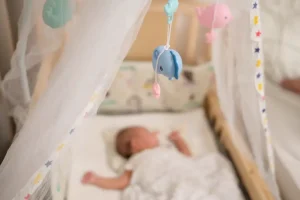
6 design tips for a calming, sleep-friendly nursery
Sleep is one of the most important aspects of your baby’s development. It supports physical and mental growth, with everything from speech to motor skills
Independent baby shop in Suffolk, nr Ipswich

It’s true – we live in a world of hand sanitisers, antibacterial everything, and dishwashers with more cycles than we’ll ever understand. But when it comes to your baby, how you sterilise baby bottles matters. Why? Because tiny immune systems need all the help they can get, especially in the first 12 months when they’re still building up defences.
Milk (especially formula) can be a breeding ground for bacteria if bottles aren’t properly cleaned. And unlike a quick rinse or even a dishwasher cycle, sterilising is the gold standard for killing off the kinds of germs that can cause tummy bugs and infections.
So whether you’re combi-feeding, bottle-feeding from the start, or expressing, this guide is here to make sterilising feel less overwhelming and more doable.
There’s no one-size-fits-all method. It’s about what fits best into your routine, your space, and your baby’s needs. Here are the main methods, with pros and cons for each.
This is the most popular option these days – quick, chemical-free, and easy.
How it works:
Steam sterilising uses high-temperature steam to kill bacteria. You can get plug-in electric sterilisers or microwave ones (just add water and zap).
Pros:
Cons:
Tip: Always double-check that your bottles are BPA-free and labelled as microwave-safe before using this method.
If you’re travelling, have limited space, or just want a no-fuss option, cold water sterilising might be for you.
How it works:
Sterilising tablets or solution are mixed with cold water in a dedicated container. Bottles soak for at least 30 minutes.
Pros:
Cons:
Tip: Make sure there are no air bubbles trapped inside bottles or teats – these can prevent full sterilisation.
The old-school method that still works – as long as you do it right.
How it works:
Place bottles in a large pan of water, bring to the boil, and keep boiling for 10 minutes.
Pros:
Cons:
Tip: Set a timer and don’t over-boil – repeated exposure to high heat can make plastic brittle or warp teats. Consider whether glass or plastic baby bottles are right for you.
Some modern dishwashers have a sterilising cycle, or reach high enough temperatures to sanitise bottles.
How it works:
Use a hot wash cycle (above 70°C), place bottles on the top rack, and use a bottle-safe basket for small parts.
Pros:
Cons:
Tip: If using a dishwasher, always follow up with steam or cold water sterilising for babies under 6 months.
Sterilising only works if your bottles are thoroughly cleaned first. That means:
Sterilising doesn’t remove milk residue – it kills bacteria. So think of it as step two in the cleaning process.
This varies by method:
The NHS recommends sterilising bottles until your baby is at least 12 months old. After that, their immune system is usually strong enough to handle normal levels of bacteria, provided bottles are thoroughly cleaned.
There’s no perfect method to sterilise baby bottles, only what works best in your home and your routine. Whether you’re steaming, soaking, or boiling, the goal is the same: protecting your baby from unnecessary germs while feeding.
Some parents go all-in on electric sterilisers. Others manage perfectly well with cold water and tablets. What matters most is consistency and cleanliness – not how fancy the method is.
And if you’re feeling the pressure, you’re not alone. You’re doing great, and this phase won’t last forever.

Sleep is one of the most important aspects of your baby’s development. It supports physical and mental growth, with everything from speech to motor skills

As the warmer evenings creep in, it’s that time when you sit down after a long day, open your laptop, and start dreaming about a

Simple and Fun Ways to Teach Kids About Sustainability In today’s world, many parents are making an effort to introduce eco-friendly activities into their children’s

Practical tips, product swaps, and small changes that make a big difference As a parent, you’re constantly making choices that shape your child’s world. And
Mamiina teething store, weaning products, eco-friendly toys, prams & strollers, and baby clothes in Suffolk.